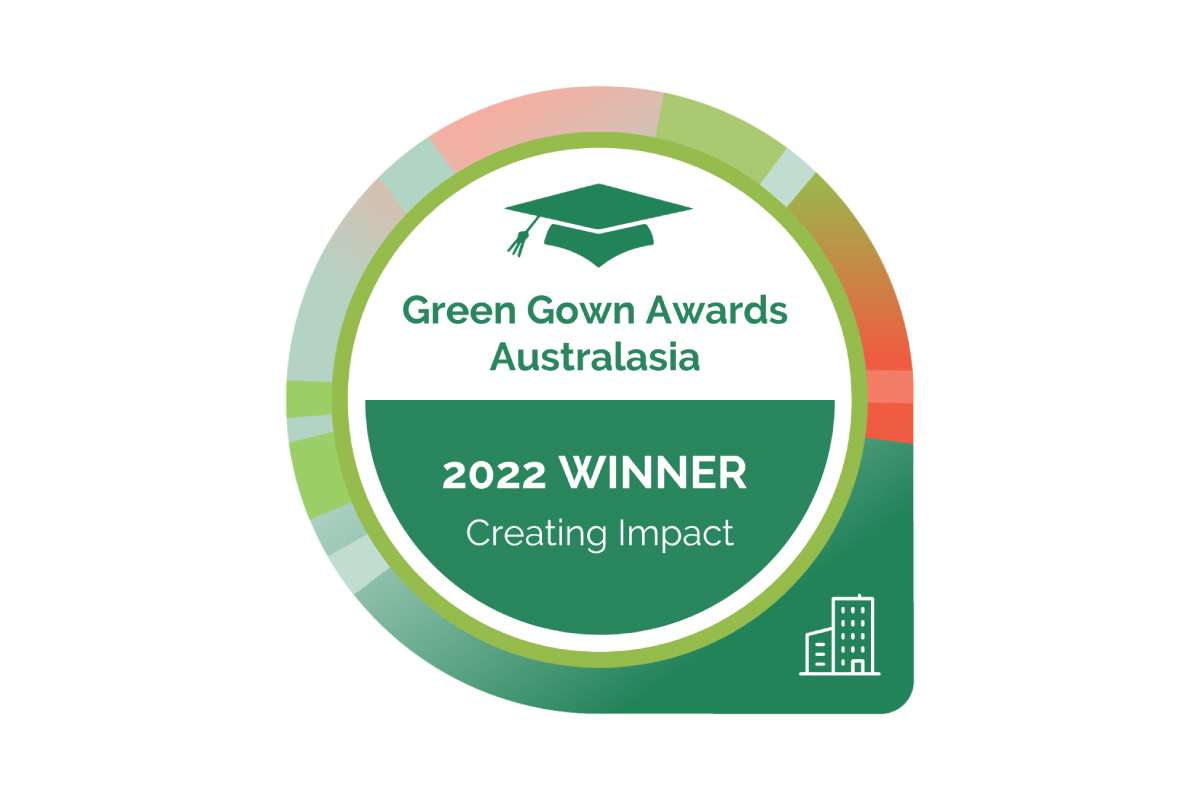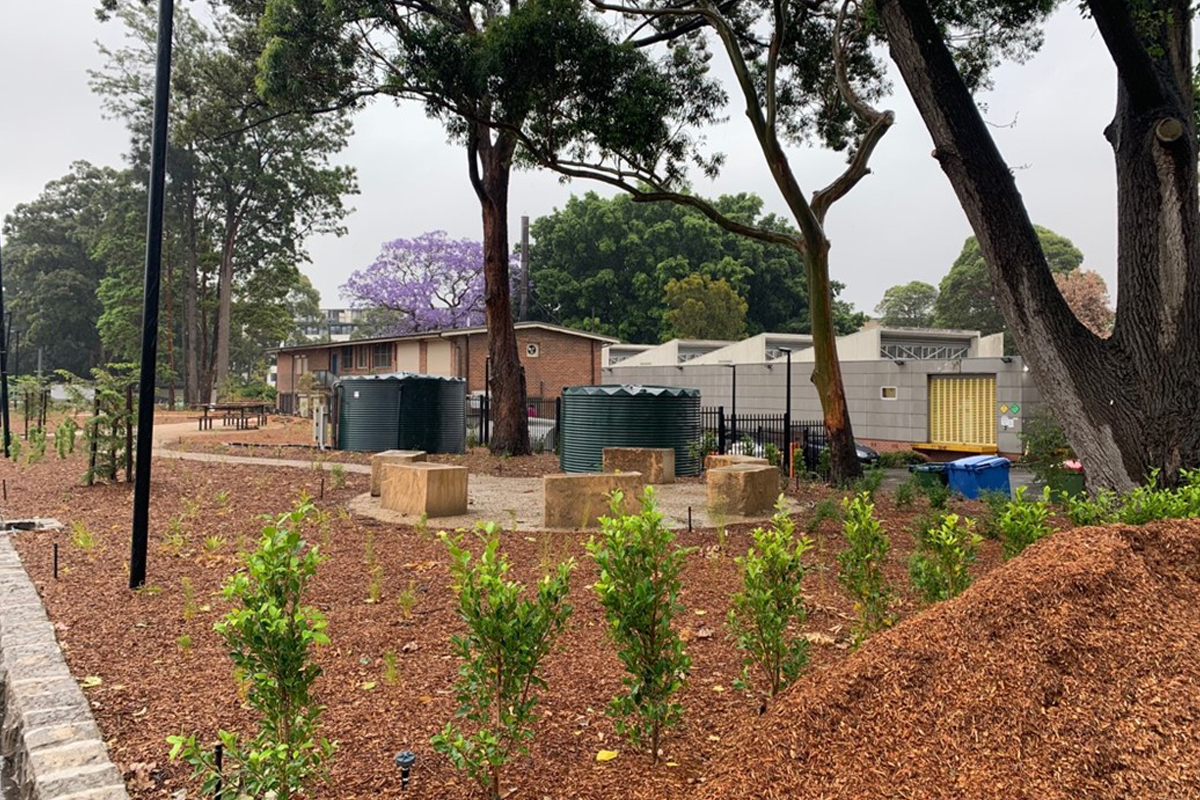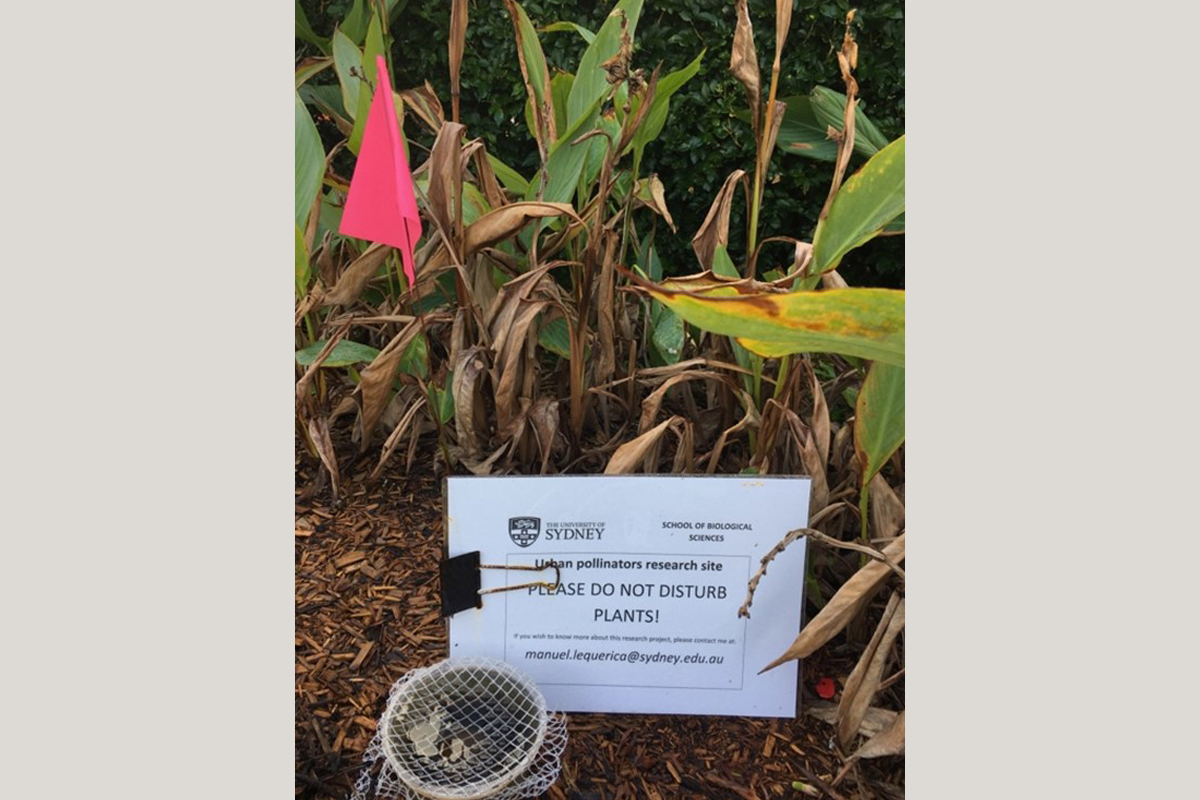
Nguragaingun, Ngara, Pemulian – our Curriculum Garden and Biodiversity Management Plan
The Curriculum Garden is a collaborative Living Lab project with Open Spaces, Botany (School of Life and Environmental Sciences), IndigiGrow (First Nations’ social enterprise) and the Sustainability Strategy working in partnership to establish an on-campus native garden.
This cultural and environmental project frames our Strategy’s Caring for Country foundation and aligns with the principles of the University’s Indigenous One Sydney, Many People Strategy. Offering an opportunity for our community to learn about local plants and Australian natives, our garden has become a living classroom. The revitalised area features plant signage in English and Sydney Indigenous languages, offers spaces for yarning, work and rest with recycled furniture and laptop power, and students can collect samples for botany labs which would otherwise need to be sourced from across NSW.
The garden extends our wildlife corridor, aids in reviving local endangered plants, and showcases sustainability on campus with our rain tanks and new biodigester.
> The initiative
To mark National Tree Day 2021 at the University of Sydney, the Sustainability Strategy team, partnering with the Open Spaces Team in Central Operations Services (COS) and academic colleagues from the School of Life and Environmental Sciences (SOLES) and Indigenous Strategy and Services, invited staff and students to plant and create a new Curriculum Native Garden.
This new garden provides an opportunity to activate and demonstrate the synergies between the Sustainability Strategy, which is underpinned by a foundation of Caring for Country, and the pillars of the One Sydney, Many People (OSMP) Strategy: Nguragaingun, Ngara, Pemulian – Sydney basin language representing Culture and community, Education and research, and Environment.
With environmental wellbeing, building a sense of place on campus and embedding Indigenous and sustainability knowledge within our curriculum key priorities for both strategies, the new garden was envisioned as a living classroom, for all members of the community to learn more about First Nations culture through plants local to the area and native to Australia and as a space to showcase sustainability in action.
Activation of the area adjacent to our rain tanks and newly installed biodigester was chosen, enabling the team to build on the existing wildlife corridor enhanced with nest boxes and native trees and to showcase our sustainability initiatives from a central location. It also had the opportunity for the space to be multi-functional, with facilities to enable staff and students to plug in laptops, the capacity to create zones for yarning circles and outdoor tutorials, and space to enable research projects and future living labs.
Internal and external partnerships were critical to the success of this project. Engaging IndigiGrow, a local Aboriginal-owned social enterprise, enabled the curation of the garden to be led by First Nations’ people, with the site examined to enable the best chance of success for the garden to flourish. Engaging IndigiGrow also enabled us to support the OSMP strategy in procuring goods and services from Aboriginal-owned businesses and meet the University’s Modern Slavery guidelines in prioritising engagement with social enterprise.
During the planting of the garden, Peter Cooley, founder of IndigiGrow and First Hand Solutions Aboriginal Corporation, shared with the Grounds team on the uses of the plants and how to best care for them. Knowledge of these plants, and their Indigenous language names, will feature in signage and added to Associate Professor Rosanne Quinnell’s CampusFlora app, featuring plant information and curated trails on campus.
With the launch of the new Curriculum Native Garden, the University also took the opportunity to release its new Biodiversity Management Plan (BMP), outlining our commitment and requirements to prioritise and facilitate more environmentally sustainable and biodiversity-positive management of our campuses, farms and lands. This Garden, as the University’s first curriculum-based Living Lab project, has become a best practice case study for the BMP and will guide the operationalisation of future Living Labs.
> Environmental and social benefits
Nguragaingun (Culture and Community):
- Respect, acknowledgment and embedding of First Nations’ culture within the physical environment of our campuses. The team has partnered with local Aboriginal-owned social enterprise IndigiGrow to supply native plants and to lead the curation of the garden, sharing knowledge to the Grounds team on each of the plants’ species and how to best care for them. In collaboration with the Indigenous portfolio and the Royal Botanical Gardens, the project will reflect Sydney Language on plant-based signage to open this knowledge to students and the broader community. The garden also features a dedicated space for community yarning circles, using sandstone blocks salvaged from a worksite destined to landfill. This integration activates and provides alignment with the University’s Indigenous One Sydney, Many People strategy and the Caring for Country foundation of the Sustainability Strategy.
Ngara (Education and Research):
- The garden will provide living lab opportunities for students and future research. The integration of operational work with our research and education is a focus of the Sustainability Strategy, with the project providing a model for other areas of the University’s to develop their own living lab-type activity, and to utilise the space to support units of study in the School of Life and Environmental Sciences and future research projects.
- The garden provides specimens for use in botany laboratory sessions. Plants for the garden were selected in collaboration with Associate Professor Rosanne Quinnell and Professor Dieter Hochuli, leading botany and ecology units at the University. Plants will be catalogued and added to the CampusFlora app (and associated trails), which is used by students as part of their experiential learning, and opens knowledges of the plants to the broader community.
Pemulian (Environment – as sense of Place):
- The planting day enabled staff, student and community engagement with sustainability. The Open Spaces team designed the planting of this site in a way that the University community could get involved and ‘get their hands dirty’ with the planting. Participation and direct engagement with sustainability strategy initiatives such as these have built awareness and enthusiasm in the community – fostering a sense of agency, ownership and pride in contributing to making the campus greener and more sustainable, and promotes ongoing sustainable behaviour changes. Participation in the planting day was also included as a Green Impact action (B004), the Sustainability Strategy’s key engagement program.
- The garden enabled planting of native species and the bridging of tree corridors – two key priorities outlined in the University’s Biodiversity Management Plan. The garden also supports other targets within the Sustainability Strategy, including reaching 30 percent canopy cover across Camperdown/Darlington campus.
- The garden will support staff and student health and wellbeing. The new garden provides short pathways and seating and tables made from 98 percent recycled plastic, allowing staff and students to enjoy in lunch breaks or to work or study outside, reflecting the importance of space for health and wellbeing outlined in the Biodiversity Management Plan.
- National Tree Day provided a concentrated opportunity to launch the Biodiversity Management Plan developed in late 2020 by academics, the Open Spaces team and key farm stakeholders. The plan is a key outcome of Strategy 9: Sustainably develop and manage the built and natural environment on our campuses to support people, plants, animals and the planet in the Sustainability Strategy 2020.
> Leadership and engagement
The Sustainability Strategy at the University of Sydney is distinctive due to its integrated commitment to sustainability, not just through operational actions but also through our research, education and commitment to engaging and embedding First Nation’s embodied knowledge and practises to heal and look after Country. This project embodies this distinction by combining these aims into one initiative.
This purpose-built garden was designed with five key aims in mind:
- To launch and put into practice our new Biodiversity Management Plan, and to collaborate and activate several commitments and targets within our Sustainability and Indigenous Strategies.
- Opening up new green and open spaces on campus – planting native species, bridging tree corridors and providing a place to showcase sustainability in action.
- Creating a space of health and wellbeing for staff, students and the community to enjoy.
- Giving botany students the ability to interact with native plants on campus as part of their studies.
- Building engagement with the community through National Tree Day activations and Green Impact, encouraging staff and student participation through the planting of the garden and learning about local and native plants. Direct engagement with Sustainability Strategy initiatives such as these have built awareness and enthusiasm in the community – fostering a sense of agency, ownership and pride in contributing to making the campus greener and more sustainable, and promoting ongoing sustainable behaviour changes.
> Significance to the sector
As the University’s first education-based Living Lab, the project has provided a working prototype for how curriculum-based learning can be incorporated within a Sustainability Living Lab model, and has created a new way of looking at open spaces with curriculum and research in mind. We plan to present our work within networks such as the Group of Eight sustainability forum and the new NSW/ACT Network forum we are establishing, with members from University sustainability teams across NSW and ACT.
> Wider societal impact
Our Camperdown/Darlington campus is an open urban campus that borders 5 inner city suburbs with high-density housing – green spaces which nurture and protect local native species are hard to find. The garden, and the expansion canopy cover and biodiversity through the University’s Biodiversity Management Plan, will benefit the revitalisation of local and Australian native species and supports the NSW Government’s priorities to greening our city to support community connection and wellbeing.
> Learner/Graduate employer impact
Students educational experience at the university is underpinned by graduate qualities such depth of disciplinary expertise, critical thinking and problem solving, and cultural competence.
Students engaging with the Curriculum Garden through biology and ecology units will have enriched understanding and appreciation of local and Australian native plants, how they grow and thrive in urban environments, and their biological structures through sample analysis. Students will also increase cultural competence through learnings of the cultural significance of plants and wholistic practices of Caring for Country.







